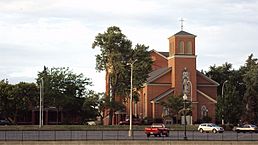St. Mary's Church Complex Historic District (Monroe, Michigan) facts for kids
Quick facts for kids |
|
|
St. Mary's Church Complex Historic District
|
|

St. Mary Church from across the River Raisin
|
|
| Location | East Elm Avenue and North Monroe Street Monroe, Michigan |
|---|---|
| Area | 60 acres (24 ha) |
| Built | 1834 |
| NRHP reference No. | 82002855 |
| Added to NRHP | May 6, 1982 |
The St. Mary's Church Complex Historic District is a special area in Monroe, Michigan. It is a collection of old buildings that are important to history. This district is located where Elm Avenue and North Monroe Street (M-125) meet. It was recognized as a Michigan Historic Site and added to the National Register of Historic Places on May 6, 1982.
Contents
Exploring the St. Mary's Church Complex
This historic area has four main buildings. The most important building is the St. Mary Church. It is located at 117 North Monroe Street.
The Historic St. Mary Church Building
The St. Mary Church has a long history. It started as a church called St. Antoine aux Rivière Raisin. This church was founded by French Canadians on October 15, 1788. It is the oldest church in Monroe County. The church building you see today was built in 1834. It was officially opened in 1839 and got its current name, St. Mary, in 1845. That year, it became part of the Roman Catholic Archdiocese of Detroit.
The Sisters of the Immaculate Heart of Mary
The Sisters, Servants of the Immaculate Heart of Mary (IHM) is a group of religious sisters. They were founded in Monroe in 1845. Their first leader was Theresa Maxis Duchemine. She was an African-American woman from Haiti. She had also helped start the Oblate Sisters of Providence. This was the first African-American religious order in the United States.
Schools in the St. Mary's Complex
In 1846, St. Mary Academy was built. This was a school just for girls. Later, Monroe Catholic Central was built next to the church. This was a school for boys. In 1986, these two schools joined together. They formed a new school called St. Mary Catholic Central (SMCC) high school. Both boys and girls could attend this school.
The SMCC high school is still located in the old Monroe Catholic Central building. This building was expanded and is at 108 West Elm Avenue. It is the largest building in the historic district. It is also the biggest private school in Monroe County.
Other Important Buildings and Changes
The original church building stayed the same from 1839 until 1903. That year, it was made larger. The Brothers of the Holy Cross residential building was built in 1870. The St. Mary Parochial Elementary School was finished in 1903. The current rectory, which is where the priests live, was added in the 1920s. Each of these buildings has its own special design. Most of the buildings in the complex have not changed much since the 1920s.
Location and Surroundings of the District
The St. Mary's Church Complex Historic District covers about 60 acres (24 hectares). It is bordered by Borgess Avenue to the west. West Willow Street is to the north. Elm Avenue is to the south, and North Monroe Street (M-125) is to the east.
This historic district is located across Elm Avenue from the George Armstrong Custer Equestrian Monument. It is also across North Monroe Street from the East Elm-North Macomb Street Historic District. The church complex is just across the River Raisin from the Old Village Historic District.



